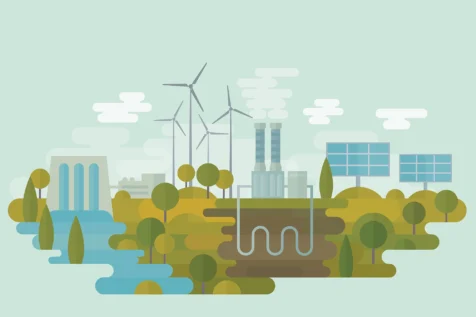The Rise of Generative AI
Generative artificial intelligence (genAI) can write code, draft marketing campaigns, generate images, and even mimic human reasoning—all without explicit training for these tasks. Yet, this performance comes at a price. Behind every AI-generated insight lies an immense computational engine, powered by data centers using electricity at an unprecedented scale. U.S. utility companies anticipate data center energy consumption demands by 2028 to equal the energy needed to power three New York cities. For business leaders, the challenge is clear: how do we harness AI’s potential without fueling a climate crisis?
The Energy Equation: Why Bigger Models Mean Bigger Footprints
A simple formula is at the heart of genAI’s environmental impact: compute ≈ 6 × parameters × tokens. Doubling a model’s parameters or training data doubles its energy needs. Training GPT-3 (with 175B parameters and 300B tokens), for instance, consumed 1,287 MWh of power—enough to fuel 108 U.S. homes for a year—and emitted 552 metric tons of CO₂. Models like Llama with 7B to 70B parameters and 2T tokens have similar power consumption and emissions, requiring 1227 MWh and emitting 539 metric tons of CO₂.
But these numbers only scratch the surface. Data centers don’t just run graphics processing units; they cool, light, and support them with auxiliary systems. The power usage effectiveness metric, averaging 1.58 in the U.S., reveals that nearly 40 percent of a data center’s energy is wasted on non-compute tasks. This inefficiency compounds as companies race to build bigger models and denser data centers.
Carbon Emissions: The Invisible Byproduct of AI Progress
The environmental cost of genAI hinges on two variables: where the energy comes from and how the model is used. A data center plugged into France’s nuclear-dominated grid emits just 0.02 kg of CO₂ per kWh. Contrast this with coal-heavy grids in parts of China, where the same kWh generates 0.9 kg of CO₂. Even within the U.S., regional disparities matter: The Pacific Northwest’s hydro-rich grid emits 0.15 kg/kWh, while the Midwest’s coal-reliant grid emits 0.55 kg/kWh.
Then comes the lifecycle problem. In LLMs, training builds the model’s intelligence by processing massive data, whereas inference is the real-time use of that intelligence to respond to user queries. Training a model like GPT-3 is just the beginning. Inference—the phase where users query the model—accounts for over 90 percent of its lifetime emissions. While generating an image (~0.03 kg CO₂) or summarizing a document (~0.02 kg CO₂) seems trivial, scale these actions to millions of daily users, and emissions quickly eclipse training costs.
The Underestimated Impact: Beyond Training
Current carbon emissions calculations often ignore critical factors. Pre-training steps—like hyperparameter tuning, neural architecture searches, and data cleaning—can multiply a model’s carbon footprint by 20x to 100x. For instance, GPT-3’s estimated 552 metric tons of CO₂ excludes the energy spent on failed experiments, iterative tweaks, hyperparameter tuning, architectural searches, and data cleaning.
Moreover, AI’s environmental toll extends beyond a carbon footprint. Data centers consume billions of gallons of water annually for cooling, while rare earth minerals in hardware fuel resource extraction and e-waste. The full picture demands a broader lens.
Charting a Sustainable Path: Solutions for Strategic Leaders
- Location Intelligence: Follow the Clean Energy
Data centers are not bound by geography. Companies like Google and Microsoft already shifted workloads to regions with greener grids. Iceland and Costa Rica, powered by geothermal and hydroelectric energy, offer near-zero emissions. Even within the U.S., aligning compute tasks with renewable-rich grids in Texas or California can slash footprints. Time-shifting workloads (load balancing) to coincide with solar noon or windy nights adds another layer of optimization.
- Hardware Evolution: Efficiency as a Competitive Edge
NVIDIA’s H100 GPU exemplifies progress. Compared to its predecessor, the V100, the H100 trains models like GPT-3 three times faster while using a third of the energy. Innovations in liquid cooling, chip design, and quantum computing promise further leaps. For businesses, upgrading hardware isn’t just about speed—it’s a sustainability imperative.
- Model Optimization: Doing More with Less
Why deploy a 1-trillion-parameter model to summarize emails? Smaller, specialized models—or distilled versions of large ones—can match performance while using far less energy. DistilBERT, for example, retains 95 percent of BERT’s accuracy with 40 percent fewer parameters. Similarly, task-specific models for translation, sentiment analysis, or summarization minimize computational bloat.
- Transparency and Accountability: The New Frontier
Regulators are waking up. The EU’s AI Act now requires emissions disclosure for high-impact models, while California’s SB 253 mandates supply chain transparency. Forward-thinking firms are preempting mandates by publishing carbon footprints per application programming interface call or offering “eco-mode” features that delay non-urgent tasks for off-peak renewable hours.
Conclusion: The Leadership Imperative
Generative AI is reshaping industries, but its legacy will hinge on how we manage its environmental trade-offs. For business leaders, the opportunity lies in reframing sustainability as a driver of innovation—not a constraint.






